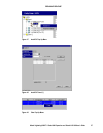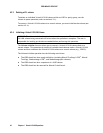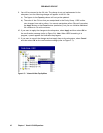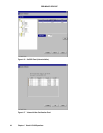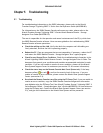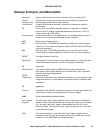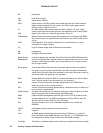PRELIMINARY RELEASE
50 Glossary, Acronyms and Abbreviations
kB kilobyte(s)
LAN local-area network
LBA logical block address
LDEV logical device. An LDEV used by mainframe hosts can be called a device,
logical volume image (LVI) or a volume. An LDEV used by open-system
hosts is called a logical unit (LU).
LU An LDEV used by open-system hosts is called a logical unit (LU). Open-
system fibre interfaces access LUs that are mapped to one or more LDEVs.
LUN logical unit number is an identifying number for an LU.
LUN Manager Remote Console software option that enables you to configure the 9900V
fibre-channel ports for operational environments, and restrict host access
to LUs.
LUSE LUN Expansion. This function allows you to concatenate two or more
volumes into a larger volume.
LVI Logical Volume Image (also called device emulation)
MB
MIB
megabyte(s)
message information block
Open Volume
Management
A suite of options that includes Virtual LVI/LUN and LUSE (LUN Expansion).
Virtual LVI/LUN divides a logical volume for open-system into two or more
volumes. LUN Expansion allows you to concatenate two or more volumes
into a larger volume.
Parity group A set of hard disk drives that have the same capacity and are treated as
one group. A parity group contains both user data and parity information,
which allows the user data to be accessed in the event that one or more of
the drives within the group are not available.
RMI™ Remote Method Invocation. RMI™ is a remote procedure call, which allows
Java™ objects stored in the network to be run remotely.
R-SIM remote service information message (generated by the 9900Vwhen it
detects an error or service requirement).
SIM service information message (generated by a subsystem when it detects an
error or service requirement).
ShadowImage An option that allows you to maintain subsystem-internal copies of all user
data for purposes such as data backup and duplication.
SNMP simple network management protocol (part of the TCP/IP protocol suite)
SSID storage subsystem ID. The 9900Vis configured with one SSID for each 64
devices, and up to four SSIDs for each CU image.
SVP Service Processor (this is the notebook computer that is inside the
RAID450).
TCP/IP transmission control protocol/internet protocol
TID target ID
Trap An SNMP agent initiates trap operations when R-SIMs occur, in order to
send the R-SIMs to the SNMP manager (see Figure 4.1). An SNMP agent can
be configured to deliver traps to more than one SNMP manager.
TrueCopy TrueCopy is an option product that allows you to perform host-free remote



